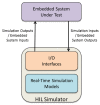An Industrial Digitalization Platform for Condition Monitoring and Predictive Maintenance of Pumping Equipment
- PMID: 31480438
- PMCID: PMC6749217
- DOI: 10.3390/s19173781
An Industrial Digitalization Platform for Condition Monitoring and Predictive Maintenance of Pumping Equipment
Abstract
This paper is concerned with the implementation and field-testing of an edge device for real-time condition monitoring and fault detection for large-scale rotating equipment in the UK water industry. The edge device implements a local digital twin, processing information from low-cost transducers mounted on the equipment in real-time. Condition monitoring is achieved with sliding-mode observers employed as soft sensors to estimate critical internal pump parameters to help detect equipment weasr before damage occurs. The paper describes the implementation of the edge system on a prototype microcontroller-based embedded platform, which supports the Modbus protocol; IP/GSM communication gateways provide remote connectivity to the network core, allowing further detailed analytics for predictive maintenance to take place. The paper first describes validation testing of the edge device using Hardware-In-The-Loop techniques, followed by trials on large-scale pumping equipment in the field. The paper concludes that the proposed system potentially delivers a flexible and low-cost industrial digitalization platform for condition monitoring and predictive maintenance applications in the water industry.
Keywords: IoT; condition monitoring; edge computing; field testing; industrial digitalization; industry 4.0; predictive maintenance; sliding mode observers; soft sensors.
Conflict of interest statement
The authors declare no conflict of interest. The funders had no role in the design of the study; in the collection, analyses, or interpretation of data; in the writing of the manuscript, or in the decision to publish the results
Figures
















References
-
- Isaksson A.J., Harjunkoski I., Sand G. The impact of digitalization on the future of control and operations. Comput. Chem. Eng. 2018;114:122–129. doi: 10.1016/j.compchemeng.2017.10.037. - DOI
-
- Dinardo G., Fabbiano L., Vacca G. A smart and intuitive machine condition monitoring in the Industry 4.0 scenario. Measurement. 2018;126:1–12. doi: 10.1016/j.measurement.2018.05.041. - DOI
-
- Mahdavinejad M.S., Rezvan M., Barekatain M., Adibi P., Barnaghi P., Sheth A.P. Machine learning for Internet of Things data analysis: A survey. Digit. Commun. Netw. 2018;4:161–175. doi: 10.1016/j.dcan.2017.10.002. - DOI
-
- Lei Y. Intelligent Fault Diagnosis and Remaining Useful Life Prediction of Rotating Machinery. Butterworth-Heinemann; Oxford, UK: 2016.
-
- Tandon N., Choudhury A. A review of vibration and acoustic measurement methods for the detection of defects in rolling element bearings. Tribol. Int. 1999;32:469–480. doi: 10.1016/S0301-679X(99)00077-8. - DOI
Grants and funding
LinkOut - more resources
Full Text Sources
Medical

